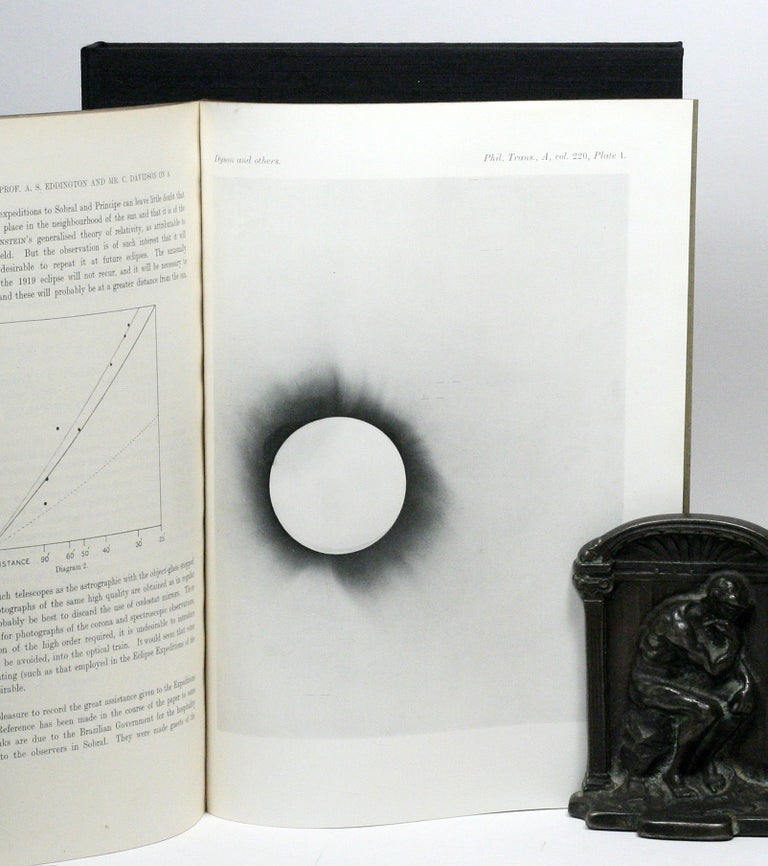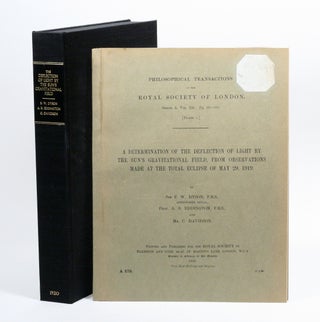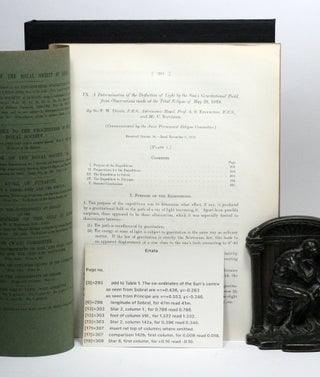A Determination of the Deflection of Light by the Sun’s Gravitational Field, from Observations Made at the Total Eclipse of May 29, 1919
“Thus the results of the expeditions to Sobral and Principe can leave little doubt that a deflection of light takes place in the neighborhood of the sun and that it is of the amount demanded by Einstein’s generalised theory of relativity, as attributable to the sun’s gravitational field."
SCARCE FIRST EDITION IN ORIGINAL WRAPPERS OF ARTHUR EDDINGTON’S REPORT CONFIRMING EINSTEIN’S GENERAL THEORY OF RELATIVITY.
“On November 7, 1919, the Einstein legend began,” for on that day the London Times boldly reported in a triple-headline:
REVOLUTIONS IN SCIENCE
NEW THEORY OF THE UNIVERSE
NEWTONIAN IDEAS OVERTHROWN
What the Times was reporting were the results, delivered the previous day at a joint meeting of the Royal Society and the Royal Astronomical Society, of the expedition led by Englishman Arthur Eddington to prove the validity of Einstein’s General Theory of Relativity.
Einstein’s theory (originally published in full in 1916) proposed that gravity resulted from the curvature of spacetime by mass. It predicted precisely how light rays would bend as they traveled along the curvature.
Eddington tested Einstein’s theory by measuring the deflection of starlight by the Sun’s gravity during a total solar eclipse. He compared the apparent positions of stars near the Sun (visible in the daytime because of the eclipse) to their positions as determined at night (when their light does not pass by the Sun).
Einstein’s theory predicted that light would be deflected twice the amount predicted by Newton’s law of universal gravitation. Eddington’s measurements proved Einstein’s prediction, not Newton’s, to be correct. When the results were announced on November 7, 1919, Einstein became an instant international celebrity.
The offered publication is Eddington’s full report as presented to the Royal Society on November 6, 1919. Complete with a magnificent large half-tone reproduction of one of the negatives taken through the telescope of the eclipse.
Note: The paper also appeared in the Memoirs of the Royal Astronomical Society, but that is just a re-printing of the paper as printed here in the Philosophical Transactions.
IN: Philosophical Transactions of the Royal Society of London. Series A, 220, pp.291-333. London: Printed and Published for the Royal Society, 1920. Complete with plate and rare errata slip; custom box. Tall quarto (approx. 9x11.5 in.) original wrappers rebacked. Label at top right of front cover (Jacques Alkan); otherwise fine. RARE.
Check Availability:
P: 212.326.8907
E: michael@manhattanrarebooks.com



